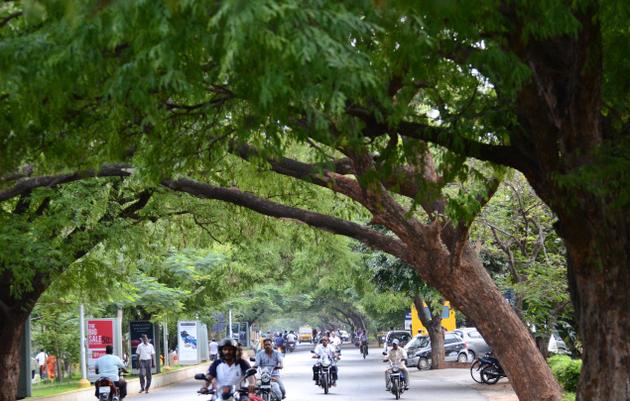
PLEASANT SHADES: A green canopy on the Race Course Road. / Photo: M. Periasamy / The Hindu
Wide road, trees on either side and the quiet neighbourhood are rapidly giving way to multi-storeyed apartments, offices, and retail outlets in Race Course, writes M. Soundariya Preetha
Valankulam, a vast water body that was away from the hustles of daily activities, birds that came to it from far, and the thick green cover around the tank were among the attractions for the British to develop a neighbourhood in what is now the Coimbatore Race Course Road.
About 150 years ago, apart from the Collector’s house, three major firms were present on Race Course Road – T. Stanes, Peirce Leslie and the Tea Estates of India. In the early 1870s came the CSI All Souls Church and the Coimbatore Club.
When young Robert Stanes came down to Coimbatore from Coonoor for treatment of an injured eye, he stayed at the Collector’s bungalow on Race Course Road. He then purchased land from the Madras Railway company (later to become the Madras and Southern Mahratta Railway and after independence the Southern Railway), which had erected temporary workshops in Coimbatore in the Race Course area, says K.S. Hegde, managing director of T. Stanes and Company.
The premises of T. Stanes and Peirce Leslie had coffee curing yards. “The Den” where Sir Robert Stanes lived, which is a small house on the Stanes premises with entrance on Tiruchi Road, the Collector’s Bungalow, and the bungalow that was part of the Peirce Leslie premises are some of the existing historical structures in the area.
“Before independence, the area had an English flavour,” says Vijay Venkataswamy, who is a Race Course resident for more than two decades and is the former president of the Race Course and Residents’ Association.
Gradually the area developed, mainly with residences for the officials. Though it is known as Race Course Road, it is believed to have never been used for competitive horse racing. Some of the elders recall how Race Course road was used by cyclists, walkers and horse riders. It was said that there were days when actor M.K. Thyagaraja Bhagavathar would ride horse on the road as part of his daily exercise, says one of them.
After independence, the locality started developing with more houses, Government offices and residences for officials coming up.
The sprawling houses, wide road, trees on either side of the road, and the quiet neighbourhood are rapidly giving way to multi-storeyed apartments, offices, and retail outlets in many parts of Race Course. Yet, it continues to be a paradise for walkers. People from across the city come to the Race Course now for their daily walk.
What is, however, worrying is that infrastructure development is inadequate. Can you believe that many houses and apartments are not connected to underground drainage system?, asks Mr. Venkataswamy.
Even 25 years ago, garbage was cleared regularly, the roads were not so polluted and vehicles were not eating into the driving space on the road.
Almost 50 per cent of the area is under commercial development now. Commercialisation started in the late 1990s and has accelerated in the last 10 years, says Mr. Venkataswamy. Initially it was corporate offices. However, there is no planned development now. Certain parts of Race Course should be zoned as only residential areas and parking and traffic flow should be regulated, he says.
source: http://www.TheHindu.com / Home> News> Cities> Coimbatore / by M. Soundariya Preetha / August 03rd, 2012

